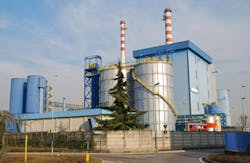Most industrial processes produce waste, some of which, if not managed properly, is hazardous and detrimental to public health and environment. More specifically, hazardous wastes are generated in producing cosmetics, detergents, pharmaceuticals, household paints and cleaning products, phones, televisions, garden pesticides, computers, gasoline and even lightbulbs.
Hazardous wastes can be liquid, solid, contained gas or sludge. They are the by-products of processing or discarded commercial products, like cleaning fluids or pesticides.
Process-production companies have made significant progress in recent years to reduce or recycle hazardous waste. However, despite their best efforts, hazardous wastes are generated each year to the tune of more than 200 million tons of hazardous waste are generated each year.
Hazardous waste is often consigned to landfills, resulting in amounts of hazardous materials seeping into the ground and nearby water sources. Today hazardous waste is often destroyed in an incinerator. Incineration reduces hazardous waste amounts, but may also generate energy throughout the gases released.
State of the nation
In the U.S., modern hazardous waste incineration is widespread and common. Destruction of hazardous waste in incinerators has been determined by the U.S. Environmental Protection Agency (EPA) to be the Best Demonstrated Available Technology (BDAT) for most organic hazardous waste because the incineration process safely and effectively destroys the hazardous constituents in waste. When performed properly, incineration eliminates the toxic constituents in hazardous waste and reduces waste volumes.
Hazardous waste combustors or incinerators are regulated under the EPA Clean Air Act (CAA) and the Resource Conservation and Recovery Act (RCRA). By requiring reductions in emissions of some of the most hazardous air pollutants, the CAA protects human health and the environment from the harmful effects of air pollution.
Incineration converts waste into ash, flue gas and heat. Ash is produced by inorganic substances in the waste and may appear as solid lumps or particulates carried by the flue gas. The flue gases can be dispersed to atmosphere, but first they must be cleaned of any gaseous and particulate pollutants. In some instances, the heat generated by the incineration process can be used to generate electric power.
Incinerators reduce the solid mass of the original waste by 80 to 85 percent and the volume by 95 to 96 percent. While incineration does not completely eliminate the need for landfilling, it does reduce the volume of waste that must be disposed. Incineration has especially strong benefits for the treatment of specific types of waste, such as clinical wastes and hazardous wastes where pathogens and toxins are destroyed by extreme high temperatures.
A typical set-up
A typical hazardous waste incinerator consists of a rotary kiln, an afterburner and an air pollution control system. Both solid and liquid wastes are introduced into the rotary kiln, in which the temperature is usually higher than 1,800 degrees F. This extremely high temperature is maintained through the use of the heat content of liquid wastes or the introduction of supplemental fuels, such as natural gas, into the chamber.
The kiln rotates slowly to ensure that the solid wastes are exposed on all sides to the high temperature in the kiln. A large fan draws the excess air into the system to increase its combustion efficiency.
Worldwide Recycling Equipment Sales, LLC, in Moberly, Missouri, offers a variety of incinerators for hazardous waste. The Vulcan hazardous waste incinerator, for example, is a 12’ diameter x 20’ long rotary drum incinerator with an air pollution controls system. This unit consists of a ram feed system and a refractory-lined rotary drum capable of operating at up to 2,600 degrees F.
During incineration, hazardous waste is fed semi-continuously by a ram feeder. The ram feeder can be automatically or manually cycled through a refractory-lined charging into the combustion chamber. The primary combustion chamber consists of the rotary drum and a 20 MMBtu burner which is controlled and modulated by a temperature controller and temperature element placed in the ductwork between the primary and secondary combustion chambers. The ash from the primary combustion unit is discharged through a refractory-lined valve placed in the discharge bridging.
Vapor from the primary combustion chamber is pulled through refractory-lined ductwork to a secondary combustion chamber, where the vapor is oxidized at temperatures up to 2,600 F for at least two seconds. The vapor from the secondary combustion chamber is pulled through a pre-cooler, where the temperature is reduced to approximately 1,400 degrees F. From the pre-cooler, the vapor is pulled through a plume eliminator, which also acts as a heat exchanger. In the plume eliminator, the fine dust particulates are removed, and the vapor is cooled to approximately 700 degrees F. Vapor from the plume eliminator is pulled through an after-cooler where it is further quenched prior to entering a Venturi scrubber and absorption tower, which are part of the air-pollution control system.
Incinerating hazardous waste decreases the load placed on landfills and prevents potentially dangerous materials within the waste from leaching out and polluting the surrounding environment. Through incineration, hazardous wastes can be safely and efficiently discarded.
For more information, visit our website, www.getavulcan.com, or contact Worldwide Recycling Equipment Sales, LLC at (660) 263-7575 or [email protected].


